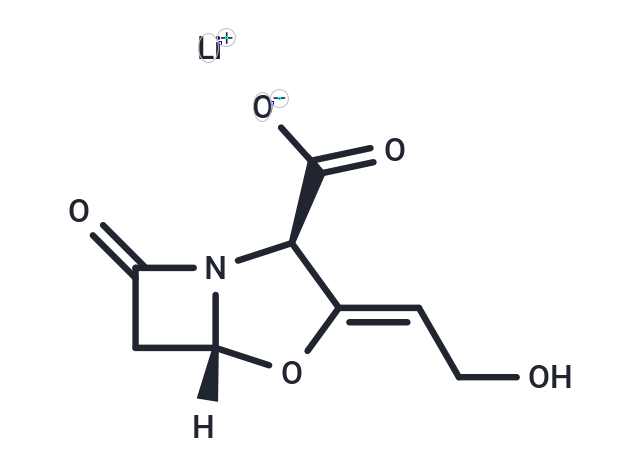Shopping Cart
- Remove All
 Your shopping cart is currently empty
Your shopping cart is currently empty

Clavulanate lithium (Clavulanic acid lithium) is an inhibitor of β-lactamase.

| Pack Size | Price | Availability | Quantity |
|---|---|---|---|
| 5 mg | $39 | In Stock | |
| 10 mg | $64 | In Stock | |
| 25 mg | $113 | In Stock | |
| 50 mg | $172 | In Stock | |
| 100 mg | $255 | In Stock | |
| 1 mL x 10 mM (in DMSO) | $50 | In Stock |
| Description | Clavulanate lithium (Clavulanic acid lithium) is an inhibitor of β-lactamase. |
| In vitro | Combination of Clavulanate lithium with beta-lactam antibiotics prevents microbial lactamases from inactivating antibiotics, but when administered alone has weak antimicrobial activity against most organisms, causing relatively slow growth inhibition[1]. |
| Alias | Clavulanic acid lithium |
| Molecular Weight | 205.09 |
| Formula | C8H8LiNO5 |
| Cas No. | 61177-44-4 |
| Smiles | [Li+].[H][C@@]12CC(=O)N1[C@@H](C([O-])=O)\C(O2)=C\CO |
| Relative Density. | no data available |
| Storage | Powder: -20°C for 3 years | In solvent: -80°C for 1 year | Shipping with blue ice. | ||||||||||||||||||||||||||||||||||||||||
| Solubility Information | H2O: 44.8 mg/mL (218.44 mM), Sonication is recommended. DMSO: 4.5 mg/mL (21.84 mM), Sonication and heating to 80℃ are recommended. | ||||||||||||||||||||||||||||||||||||||||
Solution Preparation Table | |||||||||||||||||||||||||||||||||||||||||
DMSO/H2O
H2O
| |||||||||||||||||||||||||||||||||||||||||

Copyright © 2015-2025 TargetMol Chemicals Inc. All Rights Reserved.